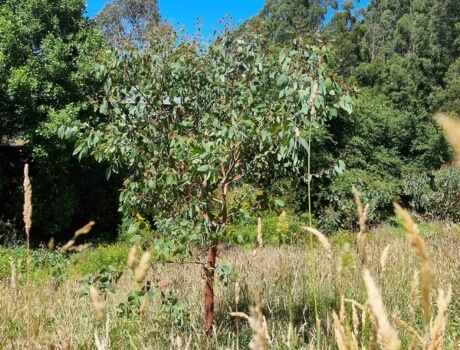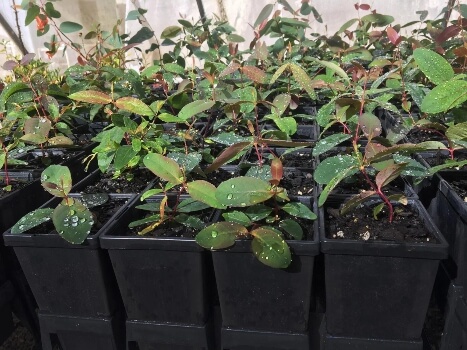Strawberry gum or forestberry is a bush tucker gem valued for its intensely aromatic, berry-scented and flavoured leaves that can be used to enhance many creations in the kitchen.
This medium-sized tree features a smooth whitish-grey flaky bark, glossy pale-green lanceolate leaves that gently arch and dainty creamy-white flowers in spring that form in small clusters.
Today I will be discussing how you can go about growing and caring for this superb bush tucker tree species in your garden.
More...

Source: Wikipedia
Family: | Myrtaceae |
|---|---|
Genus: | Eucalyptus |
Species: | E. olida |
Common Names: | Strawberry gum, strawberry gum tree, forestberry |
Location: | Outdoor |
Type: | Tree |
Growth: | 10 to 20 metres tall, 4 to 8 metres wide |
Sun requirements: | Full sun |
Foliage Colour: | Green |
Flower Colour: | White |
Flowering: | Spring |
Fruit: | N/A |
Maintenance level: | Low |
Poisonous for pets: | Toxic to cats and dogs |
Famed for its evergreen leaves that have a strong strawberry-like fragrance, this gorgeous tree also offers dense growth in its foliage and an attractive open canopy perfectly suited for backyards.
I absolutely love eucalyptus trees and we have some fantastic native species to choose from here in Australia so if you’re looking for a wonderful bush tucker tree, this may be the perfect pick for you.
Introducing the Strawberry Gum Tree

Source: Melbourne Bushfood
Botanically referred to as Eucalyptus olida, common names now include strawberry gum, strawberry gum tree and forestberry. This species is part of the Myrtaceae family (same family of Metrosideros) and is endemic to the restricted Northern Tablelands of New South Wales but is now being commonly cultivated in gardens across the country.
Though ideal for temperate regions, this tree can also be grown in subtropical conditions. Considered a slow to medium-growing species, forestberry trees will usually reach around 10 to 20 metres tall and 4 to 8 metres wide cultivated in suburban gardens.
Safety First
- This tree does have the potential to grow to 30 metres plus in optimal conditions so it may not be suitable for all suburban settings.
- It is best to plant this tree away from any buildings, paving, piping or other damageable properties.
- The leaves are also extremely rich in oils so they are highly combustible during bushfires.
How to Grow Strawberry Gum
Most professionals will recommend buying an established young and healthy nursery plant as many Eucalyptus species are toxic and hybridization can also be toxic in landscapes.
These tubestock plants will also be able to establish themselves faster and with more vigour so you can reap the benefits of the foliage sooner.
Alternatively, the strawberry gum tree can be propagated from seeds sown in containers in early spring and then planted out in midsummer with little root disturbance. Seed-grown plants can take 5 years or more to establish themselves and start producing decent harvests.
Best Planting Conditions for Eucalyptus olida

Rosebank Growers
The most ideal time to plant this species is around March when temperatures are warm and stable. Many growers would suggest starting forestberry trees in large containers placed in sheltered positions in the garden.
They tend to perform well in pots for the first 1 to 2 years. You will need to move into larger containers as the roots begin to show. After this period, your tree should be ready for the garden bed.
Alternatively, nursery plants can be transplanted straight into the garden bed with some shelter during establishment as young plants need to be protected from cold winds and frosts. A plant or tree cover could help during this time.
See these plant cover bags available online as a reference.
Ideal Soil Conditions for Eucalyptus olida
Moist and well-draining soils are ideal for forestberry. Loamy or clay-based soil types are also preferred. This tree enjoys a slightly acidic to neutral soil pH level of between 5 and 7.
Exposure
Full sun is recommended.
How to Care for Strawberry Gum Tree
Once established, this tree will be frost tolerant to -8°C but sensitive to drought. Here is how you can care for your strawberry gum tree.
Waterings
Daily watering will be required during hot dry weather. Overall, this species is thirsty and will appreciate regular watering. Water deeply and let the soil drain sufficiently if potted.
Allow the soil to dry out slightly before watering again. This is the case for both garden and pot-grown plants. Adding some seaweed solution to the water once a month or so can also encourage healthy growth.
Pruning Needs
Regular, light pruning will help with maintaining a shorter tree and a denser canopy that is more suited for backyard environments. Pruning will be essential if you intend on keeping your forestberry smaller.
Different types of plants call for distinct approaches so be sure to check out our guide to pruning Australian native plants for more info.
Feeding
Fertilise with high-quality native plant food every 6 months to a year.
Mulching
Add a thick layer of organic mulch around the base of the tree to prevent the soil from freezing and to encourage better soil moisture conservation.
See our guide on the best types of mulch for the garden here.
Staking
It is important to grow your Eucalyptus olida along a bamboo cane or similar tree stake to help condition it into an upright habit. If you intend on keeping the plant small and more shrub-like, staking won’t be necessary.Strawberry Gum Bush Tucker Guide

Source: Herbalistics
The leaves of Eucalyptus olida have been harvested commercially for perfume and flavouring since the 1980s. The leaves produce a sweet strawberry-like fragrance and flavour, perfect for many applications in the kitchen.
The oil-rich leaves are commonly used as a dried spice or herb in bushfood cooking, frequently paired with fruits and desserts, used in herbal teas or steeped in carbonated beverages.
The leaves are said to have a sweet berry taste with slightly acidic notes similar to balsamic vinegar with fruity undertones of cinnamon, strawberry and passionfruit. The leaves are said to have a mild strawberry and eucalyptus aroma.
Strawberry Gum Nutritional Benefits
- Leaves have high antioxidant activity.
- They contain antifungal and antibiotic properties that can help to balance the microflora of the gut and boost the immune system.
- There is a high concentration of essential oils in the leaves.
Harvesting Forestberry Leaves
- Leaves of established trees can be harvested as needed by simply plucking them from the branches.
- Be sure to remove any stems, twigs and branches before grinding the leaves into powder.
- If needed, you can also rinse them before use to remove any small debris.
How to Use Strawberry Gum Tree Leaves
- Leaves can be used fresh or dried.
- They are an excellent flavour enhancer to bring out that classic berry taste.
- The oil-rich leaves can be dried and ground into a spice or herb for desserts, pancakes, panna cotta, fruit salads, spiced jams, syrups, ice cream and other sweeter creations.
- Leaves can also be dried and used in herbal teas or carbonated beverages.
- Ground leaves pair brilliantly with cooked fruit dishes as well.
Here are a few tasty recipes to help get you started:
Pests and Diseases
There is little evidence available that suggests this species suffers from any notable pest or disease problems. The Myrtaceae family does inherently suffer from myrtle rust which is a currently untreatable condition.
Strawberry Gum Frequently Asked Questions

Source: Native Oils Australia
How do you make strawberry gum tea?
This is a strong-leafed, caffeine-free tea perfect for after dinner. You will only need about half a teaspoon per cup. Steep in boiling water for 3 to 4 minutes and enjoy.
Is strawberry gum edible?
Yes. The oily leaves of this tree can be harvested immediately and dried and ground into a spice for sweeter dishes.
How do you use strawberry gum powder?
The powder can be mixed with creams, meringues, frostings or ganache bases to make a large variety of desserts and sweet condiments like jams and syrups.
If you’re interested in learning how to grow other stunning Eucalyptus species in your yard, be sure to check out our in-depth guides below for more information:
Streamline Your Garden’s Bush Tucker Spirit with Strawberry Gum
The strawberry gum tree is a must-have addition for those who are avid bush tucker enthusiasts that have the space for a medium-sized tree in their backyards.
The aromatic and nutritious leaves offer growers many exciting culinary applications while the tree itself will offer gardens a lovely open-canopied presence with glossy foliage and dainty creamy-white flowers in the springtime.
Be sure to chat with your local professionals or online vendors to secure your strawberry gum plant or seeds so you can start enjoying this beloved bush tucker in your garden.
Published on December 6, 2022 by Nathan Schwartz
Last Updated on March 5, 2024




